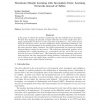Free Online Productivity Tools
i2Speak
i2Symbol
i2OCR
iTex2Img
iWeb2Print
iWeb2Shot
i2Type
iPdf2Split
iPdf2Merge
i2Bopomofo
i2Arabic
i2Style
i2Image
i2PDF
iLatex2Rtf
Sci2ools
JMLR
2010
2010
Maximum Margin Learning with Incomplete Data: Learning Networks instead of Tables
In this paper we address the problem of predicting when the available data is incomplete. We show that changing the generally accepted table-wise view of the sample items into a graph representable one allows us to solve these kind of problems in a very concise way by using the well known convex, one-class classification based, optimisation framework. The use of the one-class formulation in the learning phase and in the prediction as well makes the entire procedure highly consistent. The graph representation can express the complex interdependencies among the data sources. The underlying optimisation problem can be transformed into a on-line algorithm, e.g. a perceptron type one, and in this way it can deal with data sets of million items. This framework covers and encompasses supervised, semi-supervised and some unsupervised learning problems. Furthermore, the data sources can be chosen as not only simple binary variables or vectors but text documents, images or even graphs with comp...
Related Content
| Added | 19 May 2011 |
| Updated | 19 May 2011 |
| Type | Journal |
| Year | 2010 |
| Where | JMLR |
| Authors | Sándor Szedmák, Yizhao Ni, Steve R. Gunn |
Comments (0)

